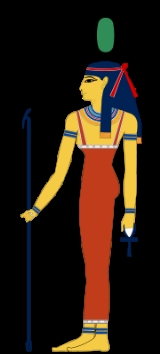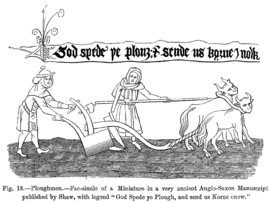
Goad
Encyclopedia


Ox
An ox , also known as a bullock in Australia, New Zealand and India, is a bovine trained as a draft animal. Oxen are commonly castrated adult male cattle; castration makes the animals more tractable...
en, which are pulling a plough
Plough
The plough or plow is a tool used in farming for initial cultivation of soil in preparation for sowing seed or planting. It has been a basic instrument for most of recorded history, and represents one of the major advances in agriculture...
or a cart
Cart
A cart is a vehicle designed for transport, using two wheels and normally pulled by one or a pair of draught animals. A handcart is pulled or pushed by one or more people...
; used also to round up cattle. It is a type of a long stick with a pointed end, also known as the cattle prod
Cattle prod
A cattle prod, also called a stock prod, is a handheld device commonly used to make cattle or other livestock move by striking or poking them, or in the case of a Hot-Shot-type prod, through a relatively high-voltage, low-current electric shock...
. Though many people are unfamiliar with them today, goads have been common throughout the world. Goads in various guises are iconographic device, and may be seen in the hand of Neith
Neith
In Egyptian mythology, Neith was an early goddess in the Egyptian pantheon. She was the patron deity of Sais, where her cult was centered in the Western Nile Delta of Egypt and attested as early as the First Dynasty...
and the 'elephant goad' or 'ankusha' (Sanskrit) in the hand of Ganesha
Ganesha
Ganesha , also spelled Ganesa or Ganesh, also known as Ganapati , Vinayaka , and Pillaiyar , is one of the deities best-known and most widely worshipped in the Hindu pantheon. His image is found throughout India and Nepal. Hindu sects worship him regardless of affiliations...
, for example.
The word is from Middle English
Middle English
Middle English is the stage in the history of the English language during the High and Late Middle Ages, or roughly during the four centuries between the late 11th and the late 15th century....
gode, from Old English gād.
According to the Bible
Bible
The Bible refers to any one of the collections of the primary religious texts of Judaism and Christianity. There is no common version of the Bible, as the individual books , their contents and their order vary among denominations...
, Judges
Book of Judges
The Book of Judges is the seventh book of the Hebrew bible and the Christian Old Testament. Its title describes its contents: it contains the history of Biblical judges, divinely inspired prophets whose direct knowledge of Yahweh allows them to act as decision-makers for the Israelites, as...
3:31, Shamgar
Shamgar
Shamgar, son of Anath is the name of one or possibly two individuals named in the Book of Judges. The name occurs twice; at the first mention Shamgar is identified as a Biblical Judge, who repelled Philistine incursions into Israelite regions, and slaughtered 600 of the invaders with an ox goad,...
son of Anath killed six hundred Philistines
Philistines
Philistines , Pleshet or Peleset, were a people who occupied the southern coast of Canaan at the beginning of the Iron Age . According to the Bible, they ruled the five city-states of Gaza, Askelon, Ashdod, Ekron and Gath, from the Wadi Gaza in the south to the Yarqon River in the north, but with...
with an oxgoad.
Tischler and McHenry (2006: p. 251) in discussing the biblical account of 'goad' hold:
In the early days, before Israel had its own metal industries, farmers had to rely on the Philistines to sharpen their goads, as well as other metal tools, the plowshares and mattocks, forks, and axes (1 Sam. 13:21).
The image of prodding the reluctant or lazy creature made this a useful metaphor for sharp urging, such as the prick of conscience, the nagging of a mate, or the "words of the wise," which are "firmly embedded nails" in human minds (Eccles. 12:11-12).
In the Latin alphabet
Latin alphabet
The Latin alphabet, also called the Roman alphabet, is the most recognized alphabet used in the world today. It evolved from a western variety of the Greek alphabet called the Cumaean alphabet, which was adopted and modified by the Etruscans who ruled early Rome...
, the letter L
L
Ł or ł, described in English as L with stroke, is a letter of the Polish, Kashubian, Sorbian, Łacinka , Łatynka , Wilamowicean, Navajo, Dene Suline, Inupiaq, Zuni, Hupa, and Dogrib alphabets, several proposed alphabets for the Venetian language, and the ISO 11940 romanization of the Thai alphabet...
is derived from the Semitic
Semitic
In linguistics and ethnology, Semitic was first used to refer to a language family of largely Middle Eastern origin, now called the Semitic languages...
crook
Crook
- Places :* Crook, County Durham, England, United Kingdom* Crook, Cumbria, England, United Kingdom* Crook, Devon, England, United Kingdom* Crook Inn, Scotland, United Kingdom* Crook, Colorado, United States* Crook County, Oregon, United States...
or goad which stood for /l/. This originally may have been based on an Egyptian hieroglyph that was adapted by Semites for alphabetic purposes. Pollack (2004: p. 146), in discussing 'Lamed, Path 22' the path from Gevurah to Tiferet, Justice, in the pathworking of the esoteric Kabbalah
Kabbalah
Kabbalah/Kabala is a discipline and school of thought concerned with the esoteric aspect of Rabbinic Judaism. It was systematized in 11th-13th century Hachmei Provence and Spain, and again after the Expulsion from Spain, in 16th century Ottoman Palestine...
, states:
We switch sides now and bring the power of Gevurah to the center. Lamed means 'goad' and in particular an ox-goad, as if we use the power of Gevurah to goad that Aleph ox, the silent letter, into a more tangible physical existence in the heart of the tree [of life]. Lamed begins the Hebrew words for both "learn" and "teach," and so encompasses the most Kabbalist of activities, study. Kabbalah has never been a path of pure sensation, but always has used study to goad us into higher consciousness. Lamed, alone of the Hebrew alphabet, reaches above the height of all the other letters. Through learning we extend ourselves above ordinary awareness.


